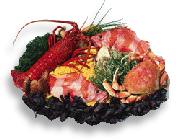
Edible Gelatins and Technical
Gelatins
The principal uses of gelatin are categorized as Edible, Pharmaceutical, Photographic and
other Technical. Gelatin comes in two forms "A" and "B" type. The two are different in the
raw material used and the process used to manufacture the gelatin. Some Edible uses
for gelatin are gelatin desserts, gummed candies, marshmallow, wine fining or clarification and
prepared meat products. Among the pharmaceutical uses are hard and soft capsules, stabilizers
for oil emulsions and glycerinated gelatin for suppositories. In the photographic industry, gelatins are
used for paper coating and as a component in silver halide emulsion coatings. Other technical
applications would be for microencapsulation, bacteriological culture media and in emulsion
polymerizations.
 Gelatin is graded and sold by its Bloom Value. This bloom value is a measurement of the
strength of a gel formed by a 6 and 2/3 % solution of the gelatin, that has been kept in a constant
temperature bath at 10 degrees centigrade for 18 hours. A device called a Texture Analyzer is
then used to measure the weight in grams that is required to depress a standard AOAC plunger 4
millimeters into the gel. If this procedure requires 200 grams, then the gelatin is a 200 bloom
gelatin. Each gelatin is also tested for its viscosity at this same 6 and 2/3 % concentration. A
standard viscosity range is associated with each bloom level gelatin. Various other analysis are
performed on the Gelatin to insure its purity. Among these other tests are micro-biological
evaluation, inorganic ash, clarity, moisture content and heavy metal content.
Gelatin is graded and sold by its Bloom Value. This bloom value is a measurement of the
strength of a gel formed by a 6 and 2/3 % solution of the gelatin, that has been kept in a constant
temperature bath at 10 degrees centigrade for 18 hours. A device called a Texture Analyzer is
then used to measure the weight in grams that is required to depress a standard AOAC plunger 4
millimeters into the gel. If this procedure requires 200 grams, then the gelatin is a 200 bloom
gelatin. Each gelatin is also tested for its viscosity at this same 6 and 2/3 % concentration. A
standard viscosity range is associated with each bloom level gelatin. Various other analysis are
performed on the Gelatin to insure its purity. Among these other tests are micro-biological
evaluation, inorganic ash, clarity, moisture content and heavy metal content.
The size of the gelatin particle may be altered by mechanical means to meet the
requirements of the individual user. Mesh ranges available go from 8 mesh to 40 mesh U.S.
Standard. Packaging available include 50 pound bags, 200 and 250 pound drums, bulk boxes
and bulk bags with various quantities.
Gelatin Grades Available: 50, 75, 100, 125, 150, 175, 200, 225, 250, 300 Bloom.
|